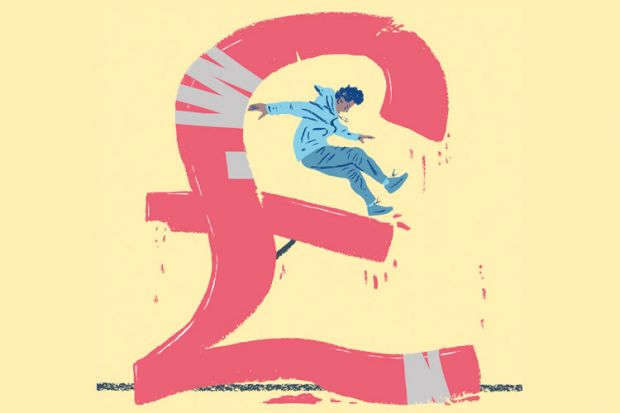Two weeks ago, David Willetts, the former universities and science minister responsible for raising the undergraduate tuition fee cap to £9,000, argued in these pages that the main threat to higher education funding in England was the “mistaken belief” among commentators that it was “unsustainable” (“It’s a winning formula, just adjust the variables”, 18 June). Nevertheless, it is the Treasury that has decided that things cannot carry on as they are.
Attention centres on the resource accounting and budgeting (RAB) charge, a budget item that reflects the fact that student loans are worth less than the money used to create them (in the jargon, their value is “impaired”). Willetts claims that the RAB charge is based on uncertain estimates that begin to affect public spending only in 30 years when the policy to write off outstanding loan balances kicks in.
That claim on its own is not inaccurate, but let’s be clear: the fiscal sustainability of higher education funding in its current form depends on the Department for Business, Innovation and Skills being allocated enough money by the Treasury to cover its commitments today. So while there is plenty of discussion to be had about the specific mechanics, RAB should not be mistaken for a mere external performance indicator.
In the 2013-14 financial year, BIS took responsibility for £9 billion of new student loans issued. This is “real” cash now, and, as even Willetts admits, it affects the level of public debt today. At the same time, BIS was credited with £1.5 billion of repayments received, but the value of all the student loans on its books increased by only £2.6 billion, not £7.5 billion, largely owing to deteriorating estimates of future repayments. Impairments on new and existing loans came to over £4 billion, and this is far worse than anticipated in 2010, when the new fees regime was determined. These numbers precipitated a major fiscal challenge for BIS, which was averted only by the provision of additional resources and by changing the budgeting conventions for student loans retrospectively.
At the same time, Treasury officials created new “incentives” for BIS to improve loan performance, and if the department does nothing it will undergo increasing cuts to planned spending over and above those yet to be confirmed in this month’s Budget and the Autumn Spending Review.
Back in 2012, Willetts told a parliamentary committee that he had read “lots of accounts” of how the RAB charge “is going to be very different, and therefore that is going to create a fiscal crisis that requires changes. Our view remains – although nobody can know – that the RAB charge is going to be at about 30%”. But just three years later, the annual RAB is at 45 per cent, and each percentage point represents over £100 million in impaired value.
Something now “requires changes” if it is to head back to the Treasury’s stated target of 36 per cent (which would see the value of each year’s new loans improve by roughly £1 billion).
What can BIS do? In the same 2012 committee appearance, Willetts pointed out that there is a “health warning” in student loan agreements: the government reserves the right to change repayment terms. Now we learn that in those “flexible” clauses lies the key to the sustainability of English undergraduate funding. They will be used not merely to vary the terms for new borrowers in response to the vagaries of the graduate labour market; Willetts wants to go further and use them to reassess the regulations every five years for everyone making repayments.
The first suggestion of both Willetts and the Universities UK Student Funding Panel, which also recently looked into the issue, is that the repayment threshold be frozen at £21,000 after 2016 rather than uprated annually in line with average earnings, as was promised. This would see the vast majority of borrowers make more repayments, but, proportionately, it will fall hardest on lower earning graduates.
Furthermore, as BIS also considers new tuition fee rises and switching maintenance grants to loans, we have the prospect of higher graduating debts. For those to be sustainable for BIS, further tightening of repayment conditions would be required beyond the “freeze”.
I’d like to add my own health warning. What is being proposed addresses one form of sustainability but threatens a more fundamental underpinning of mass higher education: public goodwill.
Given the role that online loan repayment calculators have played in persuading applicants of higher study’s affordability, any change of terms for existing borrowers will be a moral issue for many. Setting the spectre of a new mis-selling controversy to one side, we should simply note that while income-contingent loans have virtues, they make it impossible for individuals to predict with any accuracy what they are likely to repay. The prospect of amendments every five years adds further uncertainty and worry.
In place of a tempting quick fix, now would be a good moment to revisit the all-round expense of the current funding model and think about more radical alternatives.
Andrew McGettigan is author of the 2013 book The Great University Gamble: Money, Markets and the Future of Higher Education, and the recent Higher Education Policy Institute pamphlet The Accounting and Budgeting of Student Loans.
POSTSCRIPT:
Article originally published as: Impaired drivers (2 July 2015)
Register to continue
Why register?
- Registration is free and only takes a moment
- Once registered, you can read 3 articles a month
- Sign up for our newsletter
Subscribe
Or subscribe for unlimited access to:
- Unlimited access to news, views, insights & reviews
- Digital editions
- Digital access to THE’s university and college rankings analysis
Already registered or a current subscriber?




